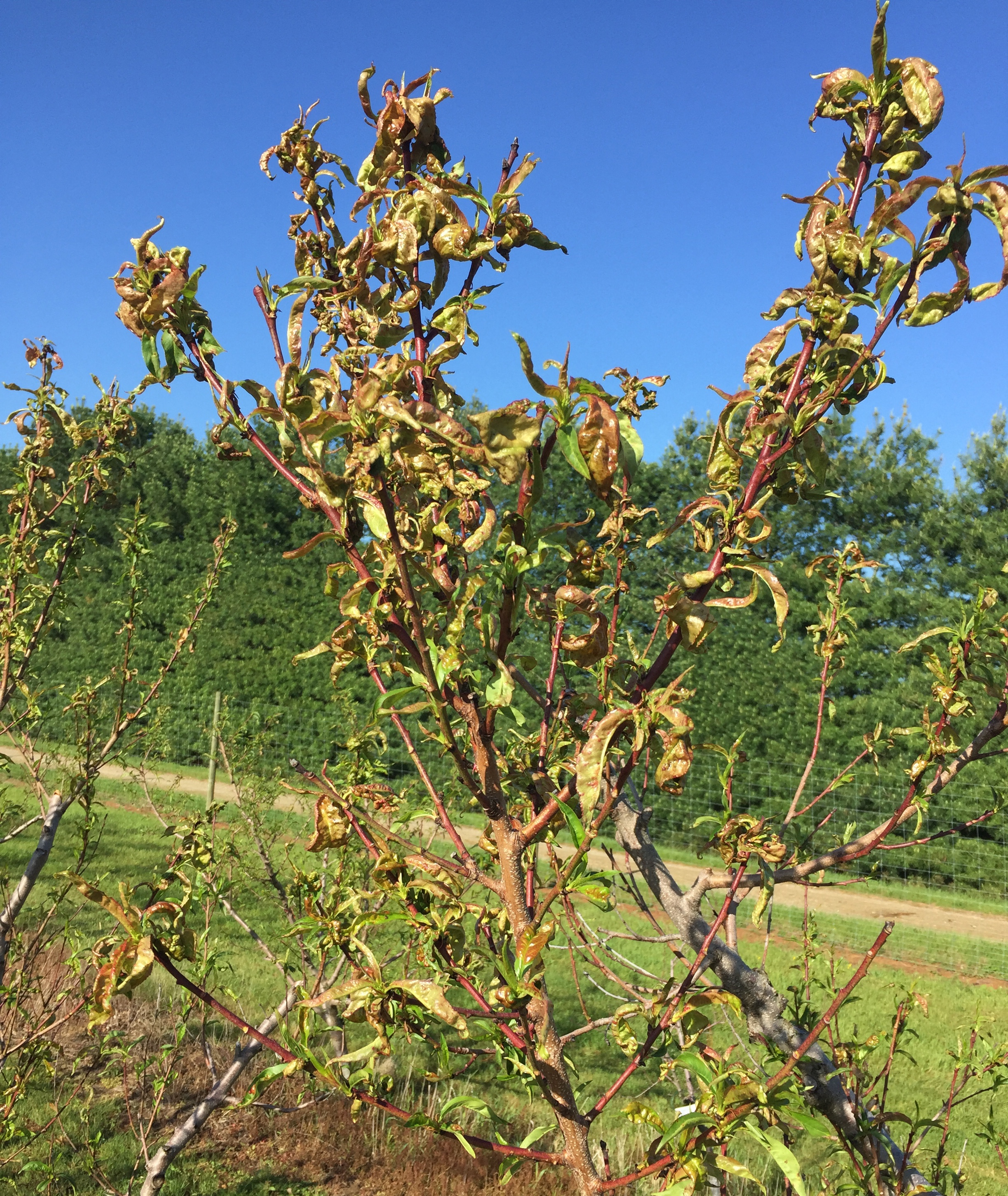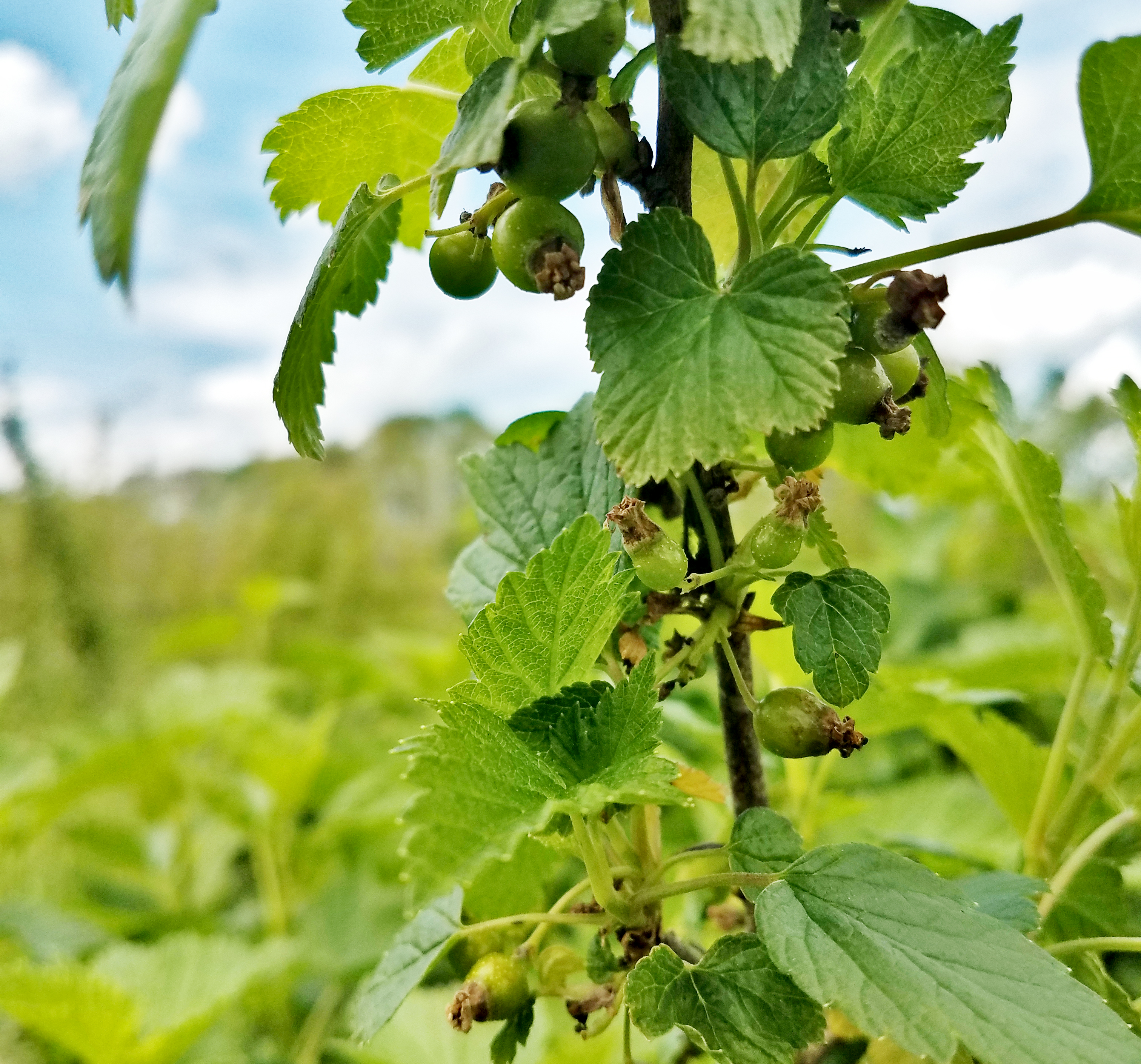Southwest Michigan fruit update – May 26, 2020
A warm week brings rapid plant development and lots of insect activity. Wet conditions this week could cause disease infections.

Weather
Last week was warm. High temperatures rose from the upper 60s into the 70s and 80s by the weekend. Lows rose into the 60s. Widespread rain fell on Sunday and Monday, May 17 and 18. The week was mainly warm and sunny in the mornings and partly cloudy in the afternoons. Scattered showers crossed the region over the weekend. Rainfall totals varied widely from over an inch to less than a tenth of an inch of rain.
Trees and other plants are rapidly leafing out with the warm weather and abundant soil moisture. Soils are drying out.
This week will continue to be warm with high temperatures in the 80s and cooling into the 70s by the weekend. There is a good chance of showers all week. Warm wet rains will be infections periods for many spring diseases.
With a warm week, we picked up more growing degree days (GDD) last week: 150 GDD base 42 and 96 GDD base 50, respectively 21 and 14 per day.
|
Southwest Michigan GDD summary from March 1 – May 25, 2020 | |||
|---|---|---|---|
|
Station |
GDD 42 F |
GDD 45 F |
GDD 50 F |
|
Benton Harbor (SWMRC) |
545 |
419 |
253 |
|
Lawton (Lawton) |
563 |
432 |
262 |
|
Fennville (TNRC) |
478 |
359 |
204 |
|
Average for the SW region |
546 |
418 |
252 |
|
Average last week |
396 |
290 |
158 |
Tree fruit
Tree fruit development has been rapid. The effects of the freezes in April and May are becoming easy to see. Oriental fruit moth and redbanded leafroller flights are well underway. Codling moth flight has started. There is still time to set up mating disruption for codling moth. The warm weather this past week has been ideal for plum curculio activity. Before spraying for plum curculio or any other insect pest, make sure bloom is completely finished and any bee hives are out of the field.
Apricots are sizing rapidly.
Peaches and nectarines range from in the shuck to completely out. Crop potential looks better in many sites now that growing fruit are more conspicuous. There is a wide range of freeze damage in the area. Now that fruit are coming out of the shuck, using mycoshield is preferable to copper for suppressing bacterial spot populations. Leaf symptoms of bacterial spot are showing up on susceptible varieties. Peach leaf curl symptoms range from slight to severe.
Oriental fruit moth flight began at the end of April. The freeze on May 9 likely killed most of the newly emerged adults. This will push back development. May 12 is a good alternative biofix date for growers that saw this hard freeze. Timing of peach scab control is approaching. Managing this disease focuses on protecting fruit starting at shuck split.

Sweet cherries are all out of the shuck, with some up to 13 millimeters in size. Tart cherries are still emerging from the shuck. Growers are examining their trees to determine the crop following the spring freezes. Sweet cherries are always susceptible to brown rot. Brown rot management is important when warm temperatures and rain occur together during bloom. There is a light tart cherry crop, but growers will still want to protect the leaves from cherry leafspot with leaves unfolded and susceptible to infection. See “Low spray programs for tart cherry” for more information.

Japanese plums have emerged from the shuck and European plums are emerging from the shuck. Crop potential is generally better for European plums than Japanese types. Sprays for black knot are targeted on protecting new shoot growth from bloom to the end of shoot growth. Young fruit are prone to russet at this point.
Apple bloom has ended for many varieties. Fruit in most advanced sites range from 3 to 6 millimeters in diameter with considerable drop of fruit underway. Warm weather and rain increase the risk of fire blight. The Maryblyt model predicted fire blight infection periods over the past weekend and continuing through the middle of the week. See “Fire blight risk very high in Michigan: Consider treatment options.” Maintain sprays to control powdery mildew and apple scab. Symptoms from late March and early April infection periods are visible now on some unprotected trees. Scab ascospores counts are going down. We are in the second half of primary scab season.
Pear fruit range from 3 to 6 millimeters in diameter. Crop load potentials are low to fair due to low temperatures on May 9. Pear scab is the primary disease concern now. Pears are out of the fire blight blossom blight window for the warmer southern part of the region.
Small fruit
Grapes have moved quickly. Shoots are expanding, with four to five leaves unfolded. Juice grape shoots are 6-12 inches long. Clusters are exposed. Wine grape varieties are further behind but also have leaves opening up. Some varieties have shoots up to 6 inches long. Protect new leaf tissue from powdery mildew infection, which is favored by high humidity and warm weather. The warm, wet weather this week also increases risk of black rot and phomopsis. Apply phomopsis sprays as leaves unfold and clusters emerge. In fields with a history of powdery mildew, choose fungicides with activity on both phomopsis and powdery mildew. Black rot control is most important later, at pre-bloom and bloom.
Blueberries are at full bloom. Damage from the May 9 freeze is easier to see, and more growers are reporting injury. Another effect of the May 9 freeze is that in some cold fields the growing tips of the shoots were killed. These shoots have stopped growth with only a few leaves. From early bloom to full bloom, the disease control focus is on controlling mummy berry flower infections. The forecast for this week is for warm conditions, good for the bees to both pollinate the flowers and spread mummy berry if it is active in your field.
After full bloom, the disease control focus shifts to controlling anthracnose infections of green fruit. In late bloom and early green fruit, focus on anthracnose and cherry fruitworms and cranberry fruitworms, which emerge during bloom. During late bloom, choose fungicides to control both anthracnose and mummy berry. Have cranberry fruitworm and cherry fruitworm pheromone traps out to determine biofix in their fields. Use the predictive tool on Enviroweather to time fruitworm control sprays.
Strawberries are blooming. While there was some damage to early bloom from the May 9 freeze, there is still a lot of good bloom in many fields.
Bramble flower buds are out and bloom is beginning. Avoid using pesticides during bloom.
Currants are finished blooming. Fruit are already up to 5 millimeters in size.

Cranberry beds still look dormant, but some spots have begun to green up and terminal buds are only slightly swollen. They should green up and move with this warm weather.
Aronia is blooming
Upcoming meetings
- Our regular southwest Monday fruit IPM updates are available online. Our next meeting is Monday, June 1, at 5:30 p.m. You need to register to receive the login and password for these meetings. The webinars are free and one pesticide applicator credit is available for each meeting. We over 70 growers attending our Monday meetings.
Related articles
- Southwest Michigan fruit update – May 19, 2020
- Effectively controlling plum curculio in stone and pome fruits
- A long wetting period could be the start of cherry leaf spot infections for 2020
- Low spray programs for tart cherry.
- Fire blight risk very high in Michigan: Consider treatment options
- Use fungicides for apple scab protection prior to anticipated early infection periods
- SDHI fungicides for apple scab management
- Scouting and management of mummy berry in blueberries
- Mummy berry has returned, and new products are available for control
- Michigan Blueberry Facts: Mummy Berry (E2846)
- Michigan Blueberry Facts: Anthracnose Fruit Rot
- Cherry fruitworm tool for IPM in blueberries
- Blueberry Fruitworm Factsheet



 Print
Print Email
Email
